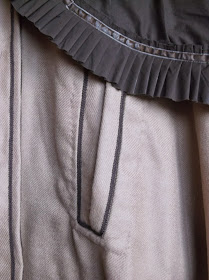Well I finally did it! I completed my entire
late 1830's outfit! Last fall you may remember I made this
purple plaid wool dress (and started this blog to chronicle making it)
Once I finished the dress I decided I was going to make a cloak and bonnet to go with it, so I tracked down patterns and bought fabric. Then life happened and I didn't get them done as soon as I'd hoped But finally, as of last week, both the cloak and bonnet are done!
I love how the entire ensemble looks!
I think I might need to make myself a muff, though, to keep my hands warm!
For the cloak I decided to make one similar to the one on the left in this fashion plate from 1842.
I made the cloak from tan wool. The capelet and lining are made out of dark brown cotton poplin.
One thing I noticed that I really liked on some cloaks from the mid 1800s was the pleats or gathers on the capelet, so I knew I wanted to add pleats to mine.
An original cloak from the mid 1800's
To do this I cut the poplin capelet pieces twice as wide as they were supposed to be and then pinned and presses the pleats into place until the outer part of the capelet was the same size as the lining. I then sewed on pleated ruffles and brown velvet ribbon to add some more texture and hold the pleats in place.
Another element I noticed in the pictures of the original cloaks I looked at was the slots on the front to stick your hands out through. By having these, while wearing the cloak, you could still use your hands and keep your cloak wrapped around you at the same time to stay warm.
To add these slots to my cloak I basically made two huge bound buttonholes, one for each hand.
They look pretty good and serve their purpose!
Those are the highlights of the cloak, so now onto the bonnet!
After looking at picture after picture of bonnets from the 1830's and 40's, I finally decided to make mine based off of this one from the early-mid 1840's.
I had already bought some tan wool for the outside of the bonnet, and some brown silk for the lining, and I had a pattern that would work perfectly, McCall's M5129, so once I figured out which bonnet I was making I got to work!
I made the bonnet form out of cotton buckram.
I then covered it with the wool, and added the silk lining.
Then it was time for the fun part! The decoration! I really liked how the band across the top of the original bonnet appeared to be gathered, so I decided to attempt something similar with some of the leftover silk.
And it turned out pretty awesome!
I sewed on some realistic looking fake flowers, and it was done!
There was only one problem, the silk was too slippery, so the bonnet kept slipping off my head to hang down my back. That was frustrating! I spent all this time making myself a bonnet and then I couldn't wear it! Well I did some more research and discovered that through the mid 1800's women still wore caps in the house. I wondered if wearing a cap under my bonnet would keep the bonnet from slipping off my head. I figured it was worth a try, so I decided to make one like this one from the mid 1830's.
Using some eyelet fabric and making up a pattern as I went, a couple hours later, this is what I had.
I love eyelet!
The cap worked splendidly! My bonnet now stays on my head with the cap beneath it, and I can look historically accurate wearing the cap with my dress indoors!
I am thrilled with how the entire ensemble came out, it's so much fun to wear (whenever I get the chance), and was so much fun to make! Now, on to my civil war ball gown!























.JPG)
.JPG)
.JPG)








.JPG)
.JPG)
.JPG)

.JPG)
